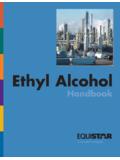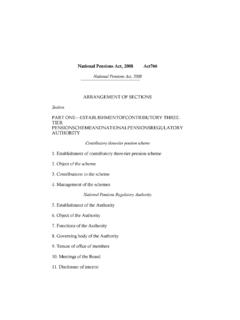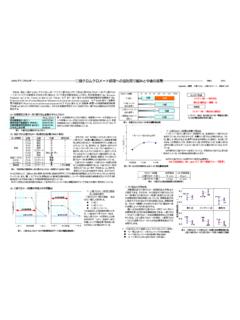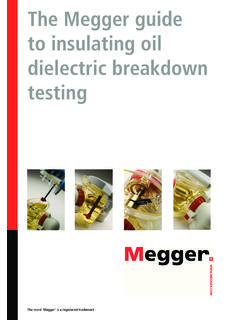Transcription of MATERIAL SAFETY DATA SHEET Denatured Fuel …
1 The Grove Country Offices 22 East Dundee Road, Suite 21 Barrington, IL 60010-7410 USA Tel: 847-304 4700 Fax: 847-304 4710 E-mail: MATERIAL SAFETY DATA SHEET Denatured fuel Ethanol Emergency Phone Numbers Call CHEMTREC California Poison Control System: (800) 3563129 North America: 800-424-9300 Others: (703) 527-3887 (Collect) Section 1. Product and Company Identification This MATERIAL SAFETY Data SHEET applies to the listed products and synonym descriptions for Hazard Communication purposes only. Technical specifications vary greatly depending on the product and are not reflected in this document. Consult specification sheets for technical information. This product contains ingredients that are considered to be hazardous as defined by the OSHA Hazard Communication Standard (29 CFR ). Product Name: Denatured fuel Ethanol Product Code: Multiple Synonyms: ITEC MSDS 004 ITECSOL AC500 ITECSOL AC600 Denatured Anhydrous Ethanol Denatured fuel Ethanol Ethanol for fuel Blending Ethanol for Gasoline Ethanol, Denatured Ethyl Alcohol, Denatured 200 Proof fuel Ethanol MSDS #: 004 CAS # : 64-17-5 Intended Use: Gasoline Blendstock Responsible Party: ITEC Refining and Marketing Co.
2 Ltd. 22 East Dundee Road Barrington, IL 60010-7410 (USA) Section 2. Hazards Identification Danger! Contains Benzene. Cancer Hazard. Can cause kidney, liver and blood disorders. May cause irritation to eyes, skin and respiratory system. Avoid liquid, mist and vapor contact. Harmful or fatal if Denatured fuel ETHANOL PAGE 1 of 14 swallowed. Aspiration hazard; can enter lungs and cause damage. May cause irritation or be harmful if inhaled or absorbed through the skin. Extremely flammable liquid. Vapors may explode. Physical state: Liquid. Emergency Overview: Danger! FLAMMABLE LIQUID AND VAPOR. CONTAINS MATERIAL THAT CAN CAUSE TARGET ORGAN DAMAGE. POSSIBLE CANCER HAZARD - CONTAINS MATERIAL WHICH MAY CAUSE CANCER, BASED ON ANIMAL DATA. Do not ingest. Avoid prolonged contact with eyes, skin and clothing. Keep away from heat, sparks and flame. Keep container closed. Use only with adequate ventilation. Wash thoroughly after handling.
3 Risk of cancer depends on duration and level of exposure. Routes of entry: Dermal contact. Eye contact. Inhalation. Ingestion. Potential acute health effects: Eyes: May cause severe irritation, redness, tearing, blurred vision and conjunctivitis. Skin: Prolonged or repeated contact may cause moderate irritation, defatting (cracking),redness, itching, inflammation, dermatitis and possible secondary infection. High pressure skin injections are SERIOUS MEDICAL EMERGENCIES. Injury may not appear serious at first. Within a few hours, tissues will become swollen, discolored and extremely painful. Inhalation: Nasal and respiratory tract irritation, central nervous system effects including excitation, euphoria, contracted eye pupils, dizziness, drowsiness, blurred vision, fatigue, nausea, headache, loss of reflexes, tremors, convulsions, seizures, loss of consciousness, coma, respiratory arrest and sudden death could occur as a result of long term and/or high concentration exposure to vapors.
4 May also cause anemia and irregular heart rhythm. Repeated or prolonged exposure may cause behavioral changes. Ingestion: Toxic if swallowed. This product may be harmful or fatal if swallowed. This product may cause nausea, vomiting, diarrhea and restlessness. DO NOT INDUCE VOMITING. Aspiration into the lungs can cause severe chemical pneumonitis or pulmonary edema/hemorrhage, which can be fatal. May cause gastrointestinal disturbances. Symptoms may include irritation, depression, vomiting and diarrhea. May cause harmful central nervous system effects, similar to those listed under "inhalation". Medical conditions aggravated by overexposure: Pre-existing disorders involving any target organs mentioned in this MSDS as being at risk may be aggravated by over-exposure to this product. Over-exposure signs/symptoms: Nasal and respiratory tract irritation, central nervous system effects including excitation, euphoria, contracted eye pupils, dizziness, drowsiness, blurred vision, fatigue, nausea, headache, loss of reflexes, tremors, convulsions, seizures, loss of consciousness, coma, respiratory arrest or sudden death could occur as a result of long term and/or high concentration exposure to vapors.
5 May also cause anemia and irregular heart rhythm. See toxicological information (section 11) Denatured fuel ETHANOL PAGE 2 of 14 Section 3. Composition, information on ingredients harzardous COMPONENTS/CAS# %VOLUME EXPOSURE LIMIT GUIDELINE OSHA PEL ACGIH TLV Ethanol / 64-17-5 95 98 1000 ppm 1000 ppm Gasoline / 86290-81-5 2 5 300 ppm 500 ppm-STEL Gasoline, Natural / 8006-61-9 2 5 300 ppm 500 ppm-STEL Xylene / 1330-20-7 2 5 100 ppm 100 ppm Toluene / 108-88-3 2 5 200 ppm 100 ppm Section 4. First Aid Measures Eye contact: Flush immediately with large amounts of water for at least 15 minutes. Eyelids should be held away from the eyeball to ensure thorough rinsing. Seek medical advice if pain or redness continues.
6 Skin contact: Remove contaminated clothing and shoes. Wash exposed area thoroughly with soap and water. Remove contaminated clothing promptly and launder before reuse. Contaminated leather goods should be discarded. If irritation persists or symptoms described in the MSDS develop, seek medical attention. High pressure skin injections are SERIOUS MEDICAL EMERGENCIES. Get immediate medical attention. Inhalation: If inhaled, remove to fresh air. If breathing is difficult, give oxygen. If not breathing, give artificial respiration. Get medical attention. Ingestion: This product may be harmful or fatal if swallowed. This product may cause nausea, vomiting, diarrhea and restlessness. DO NOT INDUCE VOMITING. Aspiration into the lungs can cause severe chemical pneumonitis or pulmonary edema/hemorrhage, which can be fatal. May cause gastrointestinal disturbances.
7 Symptoms may include irritation, depression, vomiting and diarrhea. May cause harmful central nervous system effects, similar to those listed under "inhalation". Notes to physician: No specific treatment. Treat symptomatically. Contact poison treatment specialist immediately if large quantities have been ingested or inhaled. Protection of first-aiders: No action shall be taken involving any personal risk or without suitable training. If it is suspected that fumes are still present, the rescuer should wear an appropriate mask or self-contained breathing apparatus. It may be dangerous to the person providing aid to give mouth-to-mouth resuscitation. Wash contaminated clothing thoroughly with water before removing it, or wear gloves. Section 5. Fire Fighting Measures Flammability of the product: Flammable. Products of combustion: These products are carbon oxides (CO, CO2), nitrogen and sulfur oxides (NOX, SOX), particulate matter, VOC's.
8 Fire hazards in the Presence of various Denatured fuel ETHANOL PAGE 3 of 14 substances: Extremely flammable in the presence of the following materials or conditions: open flames, sparks and static discharge. Explosion hazards in The presence of Various substances: Explosive in the presence of the following materials or conditions: open flames, sparks and static discharge. Fire-fighting media and instructions Extinguishing media Suitable: Use dry chemical, CO2, water spray (fog) or foam. Not suitable: Do not use water jet. Collect contaminated fire-fighting water separately. It must not enter the sewage system. Dike area of fire to prevent runoff. Decontaminate emergency personnel and equipment with soap and water. Highly flammable liquid and vapor. Vapor may cause flash fire. Vapors may accumulate in low or confined areas or travel a considerable distance to a source of ignition and flash back.
9 Runoff to sewer may create fire or explosion hazard. Special protective equipment for firefighters: Fire-fighters should wear appropriate protective equipment and self-contained breathing apparatus (SCBA) with a full face-piece operated in positive pressure mode. Dangerous when exposed to heat or flame. Vapors form flammable or explosive mixtures with air at room temperature. Vapor or gas may spread to distant ignition sources (pilot lights, welding equipment, electrical equipment, etc.) and flash back. Vapors may accumulate in low areas. Vapors may concentrate in confined areas. Flowing product can be ignited by self generated static electricity. Use adequate bonding and grounding to prevent static buildup. Runoff to sewer may cause fire or explosion hazard. Containers may explode in heat of fire. Irritating or toxic substances may be emitted upon thermal decomposition.
10 For fires involving this MATERIAL , do not enter any enclosed or confined space without proper protective equipment, which may include NIOSH approved self-contained breathing apparatus with full face mask. Clothing, rags or similar organic MATERIAL contaminated with this product and stored in a closed space may undergo spontaneous combustion. Transfer to and from commonly bonded and grounded containers. Special remarks on Fire hazards: Dangerous when exposed to heat or flame. Vapors form flammable or explosive mixtures with air at room temperature. Vapor or gas may spread to distant ignition sources (pilot lights, welding equipment, electrical equipment, etc.) and flash back. Vapors may accumulate in low areas. Vapors may concentrate in confined areas. Flowing product can be ignited by self generated static electricity. Use adequate bonding and grounding to prevent static buildup.





